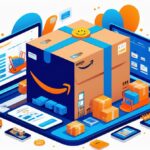Amazon FBA Program: The Ultimate Guide to Selling on Amazon Successfully
Introduction
Are you looking to start an online business with minimal hassle? The Amazon FBA (Fulfillment by Amazon) program offers a streamlined way to sell products while Amazon handles storage, packaging, and shipping. This allows you to focus on sourcing products and growing your business.
In this in-depth guide, we’ll cover everything you need to know about Amazon FBA, including how it works, its benefits, step-by-step setup, fees, and expert tips to maximize your success. Whether you’re a beginner or an experienced seller, this guide will help you navigate the Amazon FBA ecosystem effectively.
What is Amazon FBA?
Amazon FBA (Fulfillment by Amazon) is a service that allows sellers to store their products in Amazon’s warehouses. Amazon takes care of storage, packaging, and shipping, making it easier for businesses to scale.
How Does Amazon FBA Work?
- Send Inventory to Amazon – Sellers ship their products to Amazon’s fulfillment centers.
- Amazon Stores Your Products – Amazon keeps your inventory safe in its warehouse.
- Customer Places an Order – A buyer purchases your product on Amazon.
- Amazon Picks, Packs, and Ships – Amazon handles order fulfillment.
- Customer Service & Returns – Amazon manages customer support and returns.
Benefits of Selling with Amazon FBA
✅ Hands-Free Fulfillment
Amazon handles packing, shipping, and returns, freeing up your time.
✅ Prime Eligibility
FBA products qualify for Amazon Prime, increasing visibility and sales.
✅ Customer Trust
Amazon’s reliable fulfillment and customer service enhance buyer confidence.
✅ Multi-Channel Fulfillment (MCF)
You can use Amazon’s logistics for sales outside Amazon, like Shopify or eBay.
✅ Scalability
With storage and logistics managed by Amazon, sellers can focus on business growth.
How to Get Started with Amazon FBA: Step-by-Step Guide
Step 1: Create an Amazon Seller Account
- Go to Amazon Seller Central and sign up.
- Choose between an Individual (per-item fee) or Professional (monthly fee) account.
Step 2: Choose a Profitable Product
- Use tools like Jungle Scout, Helium 10, or AMZScout to find high-demand, low-competition products.
- Check product criteria:
- Lightweight (Under 2 lbs.)
- High-profit margin (30% or more)
- Not seasonal
Step 3: Source Your Products
- Find suppliers on Alibaba, ThomasNet, or U.S. wholesalers.
- Request samples to ensure product quality.
Step 4: Create an Amazon Product Listing
- Optimize your title, bullet points, description, and backend keywords.
- Use high-quality images (minimum 1000×1000 pixels).
- Enable Amazon PPC (Pay-Per-Click) for visibility.
Step 5: Send Inventory to Amazon Fulfillment Centers
- Create an FBA shipping plan in Seller Central.
- Print Amazon’s shipping labels and send your products to Amazon’s warehouses.
Step 6: Start Selling & Optimize for Growth
- Monitor your sales, adjust pricing, and optimize your listings.
- Use Amazon advertising and promotions to boost visibility.
Amazon FBA Fees & Costs
Amazon FBA isn’t free. Understanding the fee structure helps you maintain profitability.
1. Fulfillment Fees
- Based on item size and weight.
- Example: A standard-size item (0.5 lb.) costs $3.22 per unit in fulfillment fees.
2. Storage Fees
- Monthly storage fee: $0.75–$2.40 per cubic foot.
- Long-term storage fee (after 365 days): Higher charges apply.
3. Referral Fees
- Amazon takes 8%-15% of your selling price as commission.
📌 Pro Tip: Use Amazon’s FBA Fee Calculator to estimate costs before listing products.
Best Selling Categories on Amazon FBA
If you’re unsure what to sell, consider these high-demand categories:
✔ Home & Kitchen
✔ Health & Personal Care
✔ Beauty & Skincare
✔ Pet Supplies
✔ Electronics Accessories
✔ Baby Products
🚀 Tip: Avoid restricted categories like gated brands, hazardous materials, or FDA-regulated products unless you get approval.
Amazon FBA Success Tips
- Choose High-Profit Products – Avoid low-margin items with heavy competition.
- Optimize Your Listing – Use relevant keywords, compelling descriptions, and attractive images.
- Use Amazon PPC Ads – Increase visibility through sponsored ads.
- Monitor Inventory Levels – Prevent stockouts to maintain ranking.
- Leverage Amazon Coupons & Discounts – Boost conversions and sales.
📈 Case Study: A seller increased sales by 150% in 3 months by running Amazon PPC ads and optimizing listing images.
Amazon FBA Mastery
1. Is Amazon FBA worth it in 2025?
Yes! Amazon FBA remains a profitable and scalable business model for sellers worldwide.
2. Can I start Amazon FBA with $500?
It’s possible! Start with small inventory and reinvest profits to scale.
3. Do I need an LLC for Amazon FBA?
Not mandatory, but having an LLC protects your business legally.
4. How long does it take to start selling on Amazon FBA?
Typically 2-6 weeks, depending on product sourcing and shipping times.
5. What are the risks of Amazon FBA?
- High competition
- Storage fees for slow-moving inventory
- Account suspension risks if violating Amazon policies
Conclusion: Is Amazon FBA Right for You?
Amazon FBA offers an excellent opportunity to build a profitable online business with minimal logistics stress. By choosing the right products, optimizing listings, and managing costs, you can create a sustainable income stream on Amazon.
🚀 Ready to start? Sign up for an Amazon Seller Account today and take the first step toward e-commerce success!
📢 Have questions? Drop them in the comments below!








